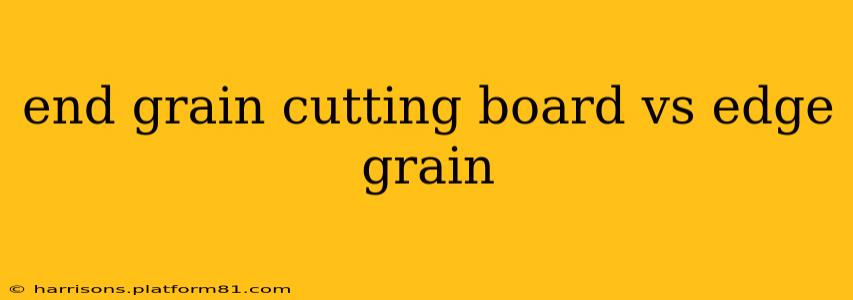Choosing the right cutting board can significantly impact your cooking experience and the longevity of your knives. Two popular types dominate the market: end-grain and edge-grain cutting boards. Understanding the key differences between these two is crucial for making an informed decision. This comprehensive guide will delve into the pros and cons of each, answering common questions and helping you choose the perfect cutting board for your kitchen.
What is an End Grain Cutting Board?
End-grain cutting boards are crafted with the wood's end grain exposed on the cutting surface. Imagine looking at the stump of a freshly cut tree – that's the orientation of the wood fibers in an end-grain board. This unique construction offers several significant advantages.
Advantages of End Grain Cutting Boards:
- Superior Knife Protection: The wood fibers in an end-grain cutting board are perpendicular to the cutting surface. This allows the fibers to "close" around the knife blade, minimizing damage and significantly reducing the risk of dulling your knives. This makes them a favorite among professional chefs.
- More Comfortable Cutting: The slightly yielding nature of the end grain provides a more comfortable cutting experience, reducing hand fatigue during extended chopping sessions.
- Self-Healing Properties: Minor cuts and scratches tend to close up naturally, extending the life of the board.
Disadvantages of End Grain Cutting Boards:
- Higher Cost: End-grain cutting boards are typically more expensive than edge-grain boards due to the more complex manufacturing process and the greater amount of wood required.
- More Prone to Swelling: Because of the larger exposed surface area of the pores, end-grain boards can absorb more moisture, leading to swelling if not properly cared for.
- More Maintenance: Requires more diligent cleaning and oiling to prevent damage and maintain hygiene.
What is an Edge Grain Cutting Board?
Edge-grain cutting boards feature wood fibers running parallel to the cutting surface. Think of a plank of wood – the long, flat surface is the edge grain. While less expensive, they offer a different set of characteristics.
Advantages of Edge Grain Cutting Boards:
- Lower Cost: Edge-grain boards are generally less expensive than end-grain boards.
- Less Prone to Swelling: The smaller surface area of exposed pores makes them less susceptible to swelling.
- Easier Maintenance: Require less frequent oiling and are easier to clean.
Disadvantages of Edge Grain Cutting Boards:
- Knife Dullness: The parallel wood fibers can dull knives more quickly than end-grain boards.
- Less Comfortable Cutting: The harder, flatter surface can be less comfortable for prolonged use.
- Less Durable: More susceptible to deep gouges and damage.
What Type of Wood is Best for Cutting Boards?
The type of wood used also significantly impacts a cutting board's performance and longevity. Hardwoods like maple, cherry, and walnut are popular choices due to their density and durability. However, softer woods like pine are generally not recommended for cutting boards due to their susceptibility to damage.
How Do I Care for My Cutting Board?
Regardless of whether you choose end-grain or edge-grain, proper care is essential for extending the life of your cutting board. Regular cleaning, oiling, and avoiding soaking in water are crucial.
Which Cutting Board is Better for Me?
The "better" cutting board depends entirely on your priorities and budget.
- Choose end-grain if: You prioritize knife protection, cutting comfort, and are willing to invest in a higher-quality, longer-lasting board that requires more maintenance.
- Choose edge-grain if: You're on a tighter budget and prioritize ease of maintenance over maximum knife protection and cutting comfort.
Are there other types of cutting boards?
Yes, besides end-grain and edge-grain, you can find cutting boards made from other materials like plastic, bamboo, or even glass. Each material offers its own set of pros and cons, and the best choice will depend on your individual needs and preferences.
How often should I oil my cutting board?
The frequency of oiling depends on the type of wood and usage. However, a good rule of thumb is to oil your cutting board every few weeks or months, or whenever it starts to feel dry.
Can I use a dishwasher to clean my cutting board?
Generally, it's best to avoid dishwashers for both end-grain and edge-grain cutting boards as the high heat and harsh detergents can damage the wood. Hand washing with warm water and soap is always recommended.
By carefully considering these factors, you can choose a cutting board that will serve you well for years to come, enhancing your culinary experience and protecting your valuable knives.
